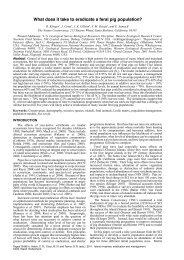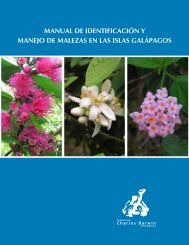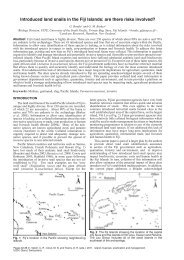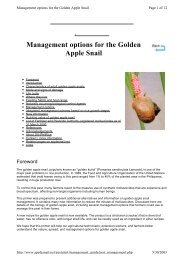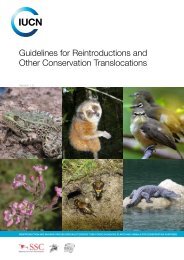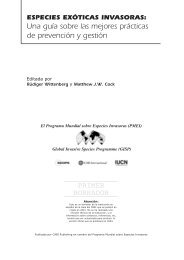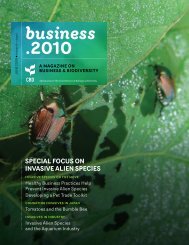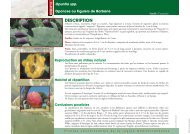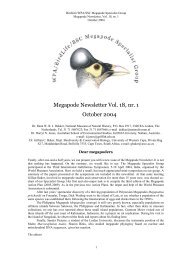Woody Invasive Species: A Regional Assessment - IUCN Invasive ...
Woody Invasive Species: A Regional Assessment - IUCN Invasive ...
Woody Invasive Species: A Regional Assessment - IUCN Invasive ...
You also want an ePaper? Increase the reach of your titles
YUMPU automatically turns print PDFs into web optimized ePapers that Google loves.
Kueffer & Vos <strong>Woody</strong> <strong>Invasive</strong> <strong>Species</strong>: A <strong>Regional</strong> <strong>Assessment</strong><br />
• Phase 1: Before 1760, First settlements. Limited impact, introduction of alien<br />
animals.<br />
• Phase 2: 1760-1830, Permanent settlements. Main introductions of alien plant<br />
species, destruction of lowland habitats.<br />
• Phase 3: 1830-1960s, Fast population & economic growth. Main habitat<br />
destruction<br />
• Phase 4: After 1960s, Post-colonial phase. Mainly accidental introductions, and<br />
propagation of exotic ornamentals<br />
Main invasive species<br />
The invasive species compiled in the report were categorized into three groups:<br />
i) main invasives, ii) non-consensus species, and iii) potentially new invasives. Main<br />
invasive species were mentioned by most of the experts consulted and in the literature.<br />
Non-consensus species were rated as invasive only by a sub-set of the experts consulted<br />
and literature. Potentially invasive species show a tendency to naturalize in the country<br />
and proved to be invasive in other countries of the tropics. The main invasive species<br />
were further rated as either a.) most problematic or b.) problematic. The species that are<br />
most problematic in at least one country of the region are compiled in table 2.<br />
<strong>Species</strong><br />
Acacia mangium<br />
Acacia auriculiformis<br />
Alstonia macrophylla<br />
Comoros La<br />
Arch. Réunion<br />
**<br />
** (*)<br />
Mauritius<br />
Seychelles Tropics<br />
**<br />
Ardisia crenata * ** * 1<br />
Casuarina equisetifolia (*) ** (*) ** 3<br />
Cinnamomum verum * (*) (*) ** 2<br />
Clidemia hirta ** ** * * 3<br />
Hiptage benghalensis ** ** 2<br />
Lantana camara ** ** ** * 3<br />
Ligustrum robustum ** ** 3<br />
Litsea glutinosa ** * (*) (*) 3<br />
Paraserianthes falcataria ** 2<br />
Psidium cattleianum ** ** ** ** 3<br />
Ravenala<br />
(*) ** (*) 3<br />
madagascariensis<br />
Rubus alceifolius (*) ** ** 3<br />
Schinus terebinthifolius * ** 3<br />
Solanum mauritianum (*) ** (*) 3<br />
Spathodea campanulata<br />
Syzigium jambos<br />
**<br />
**<br />
(*)<br />
**<br />
(*)<br />
**<br />
(*)<br />
**<br />
2<br />
2<br />
Ulex europeaus ** (*) 3<br />
Table 2. The woody invasive species that are very problematic in at least one country of<br />
the Western Indian Ocean region. (*): potentially invasive or non-consensus, *: main<br />
invasive, **: most problematic invasive. 1: potentially invasive; 2: moderately invasive;<br />
3: highly invasive according to Binggeli et al. (1998).<br />
(*)<br />
3<br />
25



